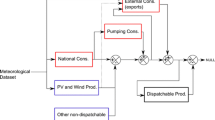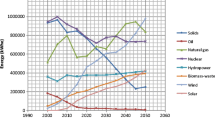Abstract
Background, aim and scope
This paper discusses the identification of the environmental consequences of marginal electricity supplies in consequential life cycle assessments (LCA). According to the methodology, environmental characteristics can be examined by identifying affected activities, i.e. often the marginal technology. The present ‘state-of the-art’ method is to identify the long-term change in power plant capacity, known as the long-term marginal technology, and assume that the marginal supply will be fully produced at such capacity. However, the marginal change in capacity will have to operate as an integrated part of the total energy system. Consequently, it does not necessarily represent the marginal change in electricity supply, which is likely to involve a mixture of different production technologies. Especially when planning future sustainable energy systems involving combined heat and power (CHP) and fluctuating renewable energy sources, such issue becomes very important.
Materials and methods
This paper identifies a business-as-usual (BAU) 2030 projection of the Danish energy system. With a high share of both CHP and wind power, such system can be regarded a front-runner in the development of future sustainable energy systems in general. A strict distinction is made between, on the one hand, marginal capacities, i.e. the long-term change in power plant capacities, and on the other, marginal supply, i.e. the changes in production given the combination of power plants and their individual marginal production costs. Detailed energy system analysis (ESA) simulation is used to identify the affected technologies, considering the fact that the marginal technology will change from one hour to another, depending on the size of electricity demand compared to, among others, wind power and CHP productions. On the basis of such input, a long-term yearly average marginal (YAM) technology is identified and the environmental impacts are calculated using data from ecoinvent.
Results
The results show how the marginal electricity production is not based solely on the marginal change in capacity but can be characterised as a complex set of affected electricity and heat supply technologies. A long-term YAM technology is identified for the Danish BAU2030 system in the case of three different long-term marginal changes in capacity, namely coal, natural gas or wind power.
Discussion
Four analyses and examples of YAMs have been used in order to present examples of the cause–effect chain between a change in demand for electricity and the installation of new capacity. In order to keep open the possibilities for further analysis of what can be considered the marginal technology, the results of four different situations are provided. We suggest that the technology mix with the installation of natural gas or coal power plant is applied as the marginal capacity.
Conclusions
The environmental consequences of marginal changes in electricity supply cannot always be represented solely by long-term change in power plant capacity, known as the long-term marginal technology. The marginal change in capacity will have to operate as an integrated part of the total energy system and, consequently, in most energy systems, one will have to identify the long-term YAM technology in order to make an accurate evaluation of the environmental consequences.
Recommendations and perspectives
This paper recommends a combination of LCA and ESA as a methodology for identifying a complex set of marginal technologies. The paper also establishes values for Danish marginal electricity production as a yearly average (YAM) that can be used in future LCA studies involving Danish electricity.




Similar content being viewed by others
References
Alberg Ostergaard P (2003) Transmission-grid requirements with scattered and fluctuating renewable electricity-sources. Appl Energy 76(1–3):247–255
Kofoed-Wiuff A, Lindboe HH, Togeby M (2007) Hvor ender vindmøllestrømmen? Naturlig Energi 29(11):16–18
Andersen AN, Lund H (2007) New CHP partnerships offering balancing of fluctuating renewable electricity productions. J Clean Prod 15(3):288–293
Blarke M, Lund H (2007) Large-scale heat pumps in sustainable energy systems: system and project perspectives. Therm Sci 11(3):141–152
Curran MA, Mann M, Norris G (2005) The international workshop on electricity data for life cycle inventories. J Clean Prod 13(8):853–862
Dalgaard R, Schmidt JH, Halberg N, Christensen P, Thrane M, Pengue WA (2008) LCA of soybean meal. Int J Life Cycle Assess 13(3):240–254
Dones R, Ménard M, Gantner U (1998) Choice of electricity-mix for different LCA applications. Brussels, Belgium
ecoinvent (2004) ecoinvent, ecoinvent data v1.3. Final reports ecoinvent 2000 no. 1-15. Swiss Centre for Life Cycle Inventories, Dübendorf
Ekvall T, Weidema B (2004) System boundaries and input data in consequential life cycle inventory analysis. Int J Life Cycle Assess 9(3):161–171
Eriksson O, Finnveden G, Ekvall T, Bjorklund A (2007) Life cycle assessment of fuels for district heating: a comparison of waste incineration, biomass- and natural gas combustion. Energy Policy 35(2):1346–1362
Frees N, Weidema BP (1998) Life cycle assessment of packaging systems for beer and soft drinks. Energy and transport scenarios. Miljoestyrelsen (Danish EPA), Copenhagen
Hauschild M, Wenzel H (1998) Environmental assessment of products—volume 2: scientific background. Chapman and Hall, London
Lund H (2003) Flexible energy systems: integration of electricity production from CHP and fluctuating renewable energy. International Journal of Energy Technology and Policy 1(3):250–261
Lund H (2005) Large-scale integration of wind power into different energy systems. Energy 30(13):2402–2412
Lund H (2007a) EnergyPLAN—Advanced energy systems analysis computer model—Documentation version 7.0. Aalborg University, Aalborg, Denmark. http://www.energyPLAN.eu
Lund H (2007b) Renewable energy strategies for sustainable development. Energy 32(6):912–919
Lund H, Andersen AN (2004) Optimising small CHP-plant performance in a competitive market: comparing Russia and Denmark. Conference Proceedings, 2nd Russia Power Conference and Exhibition, Moscow, 10–11 March 2004
Lund H, Mathiesen BV (2006a) Ingeniørforeningens Energiplan 2030—Tekniske energisystemanalyser, samfundsøkonomisk konsekvensvurdering og kvantificering af erhvervspotentialer. Baggrundsrapport (Danish Society of Engineers’ Energy Plan 2030). Danish Society of Engineers (Ingeniørforeningen Danmark), Copenhagen
Lund H, Mathiesen BV (2006b) Ingeniørforeningens Energiplan 2030—Tekniske energisystemanalyser, samfundsøkonomisk konsekvensvurdering og kvantificering af erhvervspotentialer. Baggrundsrapport (Danish Society of Engineers’ Energy Plan 2030). Danish Society of Engineers (Ingeniørforeningen Danmark), Copenhagen
Lund H, Mathiesen BV (2010) Energy system analysis of 100 per cent renewable energy systems. Energy 34(5):524–531. doi:10.1016/j.energy.2008.04.003. May 2009
Lund H, Münster E (2003) Management of surplus electricity-production from a fluctuating renewable-energy source. Appl Energy 76(1–3):65–74
Lund H, Munster E (2003) Modelling of energy systems with a high percentage of CHP and wind power. Renew Energy 28(14):2179–2193
Lund H, Munster E (2006a) Integrated energy systems and local energy markets. Energy Policy 34(10):1152–1160
Lund H, Munster E (2006b) Integrated transportation and energy sector CO2 emission control strategies. Trans Policy 13(5):426–433
Lund H, Salgi G, Elmegaard B, Andersen AN (2009) Optimal operation strategies of compressed air energy storage (CAES) on electricity spot markets with fluctuating prices. Appl Therm Eng 29:799–806
Mathiesen BV, Münster M, Fruergaard T (2007) Energy system analyses of the marginal energy technology in life cycle assessments. SETAC Europe 14th LCA Case Studies Symposium, Göteborg, Sweden, pp 15–18
Mathiesen BV, Münster M, Fruergaard T (2009) Uncertainties related to the identification of the marginal energy technology in consequential life cycle assessments. J Clean Prod 17:1331–1338
Mathiesen BV, Lund H, Norgaard P (2008) Integrated transport and renewable energy systems. Util Policy 16(2):107–116
Münster M (2007) Use of waste for heat, electricity and transport—challenges when performing energy system analysis. Proceedings from 4th Dubrovnik Conference on Sustainable Development of Energy, Water and Environment Systems. Dubrovnik, Croatia
Nordheim E, Weidema BP (1999) Marginal production technologies for life cycle inventories (multiple letters). Int J Life Cycle Assess 4(6):308
Salgi G, Lund H (2008) System behaviour of compressed-air energy-storage in Denmark with a high penetration of renewable energy sources. Appl Energy 85(4):182–189
Schmidt JH, Weidema BP (2008) Shift in the marginal supply of vegetable oil. Int J Life Cycle Assess 13(3):235–239
Schmidt AC, Jensen AA, Clausen AU, Kamstrup O, Postlethwaite D (2004) A comparative life cycle assessment of building insulation products made of stone wool, paper wool and flax. Part 1: background, goal and scope, life cycle inventory, impact assessment and interpretation. Int J Life Cycle Assess 9(1):53–66
Simapro (2007) SIMAPRO 7.1 Pre Consultants: Amersfort. The Netherlands. www.pre.nl
The Danish Ministry of Transport and Energy (2005) Energy Strategy 2025—perspectives to 2025 and draft action plan for the future electricity infrastructure. The Danish Ministry of Transport and Energy, Copenhagen
Thrane M (2004) Environmental impacts from Danish fish products—hot spots and environmental policies. PhD dissertation, Department of Development and Planning, Aalborg University
Weidema B (2003) Market information in life cycle assessment. Environmental Project No. 863. Danish Environmental Protection Agency, Copenhagen
Weidema BP, Frees N, Nielsen AM (1999) Marginal production technologies for life cycle inventories. Int J Life Cycle Assess 4(1):48–56
Wenzel H, Hauschild M, Alting L (1997) Environmental assessment of products—volume 1: methodology, tools and case studies in product development. Chapman and Hall, London
Acknowledgements
The work presented in this paper is a result of the research project Coherent Energy and Environmental System Analysis (CEESA), partly financed by The Danish Council for Strategic Research.
Author information
Authors and Affiliations
Corresponding author
Rights and permissions
About this article
Cite this article
Lund, H., Mathiesen, B.V., Christensen, P. et al. Energy system analysis of marginal electricity supply in consequential LCA. Int J Life Cycle Assess 15, 260–271 (2010). https://doi.org/10.1007/s11367-010-0164-7
Received:
Accepted:
Published:
Issue Date:
DOI: https://doi.org/10.1007/s11367-010-0164-7




